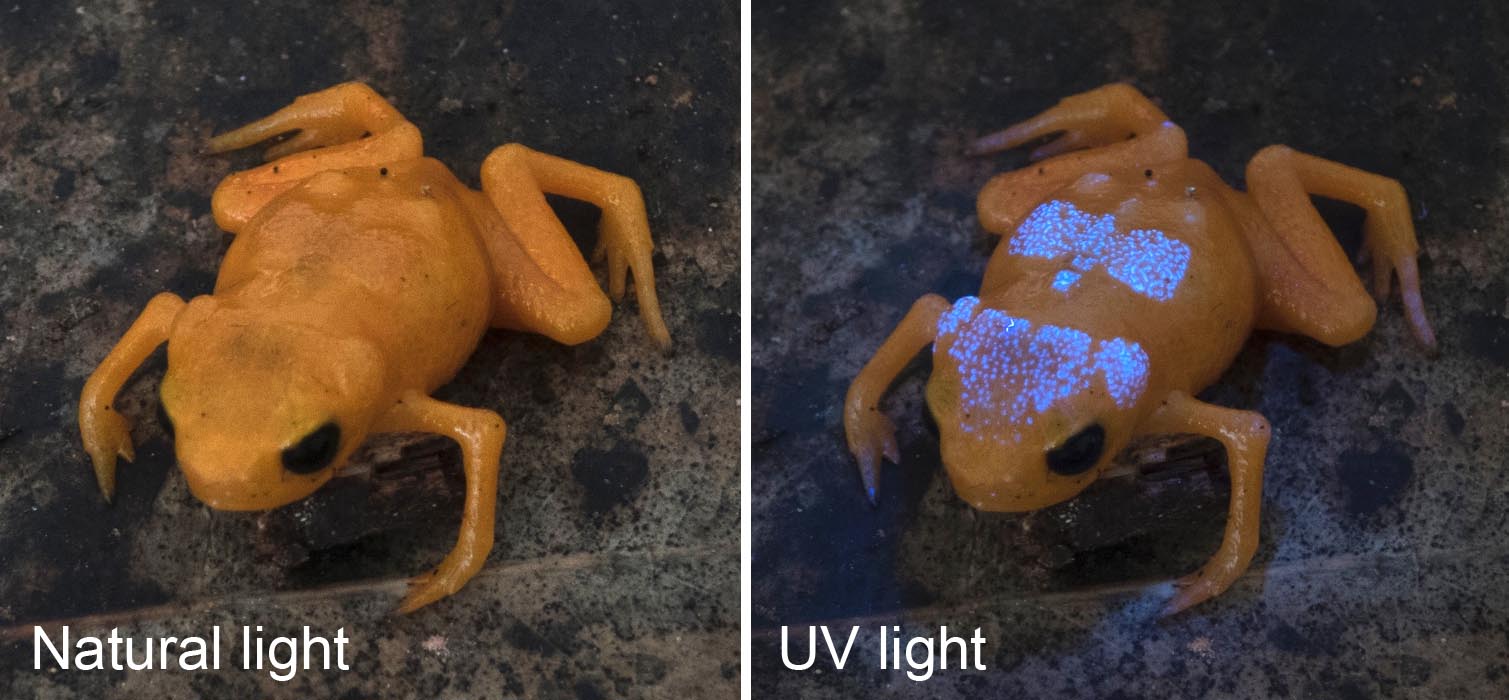Dr. Matthew Mason: Further Information...
University Physiologist Tel: +44 (0)1223 333829, Fax: +44 (0)1223 333840, E-mail: mjm68@cam.ac.uk
Goutte, S., Mason, M.J., Antoniazzi, M.M., Jared, C., Merle, D., Cazes, L., Toledo, L.F., el-Hafci, H., Pallu, S., Portier, H., Schramm, S., Gueriau, P., Thoury, M. (2019) Intense bone fluorescence reveals hidden patterns in pumpkin toadlets. Scientific Reports 9 (5388): 1-8.
 Pumpkin toadlets are tiny, brightly-colored, poisonous frogs inhabiting the forest floor of the Brazilian Atlantic forest. During the mating season, they can be seen by day walking around the forest floor and producing their soft buzzing calls, in search of a mate. In 2016, I was part of an international team of researchers led by Dr Sandra Goutte (NYU Abu Dhabi), studying the acoustic communication of these miniature frogs. When we discovered that Brachycephalus could not hear its own mating calls (Goutte et al., 2017), we searched for potential visual signals the frogs could use to communicate instead. To our great surprise, when we shone an ultra-violet (UV) lamp at the frogs, their backs and heads glowed intensely.
Pumpkin toadlets are tiny, brightly-colored, poisonous frogs inhabiting the forest floor of the Brazilian Atlantic forest. During the mating season, they can be seen by day walking around the forest floor and producing their soft buzzing calls, in search of a mate. In 2016, I was part of an international team of researchers led by Dr Sandra Goutte (NYU Abu Dhabi), studying the acoustic communication of these miniature frogs. When we discovered that Brachycephalus could not hear its own mating calls (Goutte et al., 2017), we searched for potential visual signals the frogs could use to communicate instead. To our great surprise, when we shone an ultra-violet (UV) lamp at the frogs, their backs and heads glowed intensely.
The fluorescent patterns are created by bony tissue lying directly beneath a very thin epidermis. In fact, the whole toadlet’s skeleton is highly fluorescent, but the fluorescence is only externally visible where the bone is very close to the surface. The lack of dark skin pigment (melanophores) and the thinness of the skin allows the ultraviolet light to pass through and excite the fluorescence of the bony plates of the skull and back. Striking patterns can then be seen as bluish-white markings by the observer. We compared the skeletons of the two species of pumpkin toadlets to one closely related, non-fluorescent species. The pumpkin toadlets’ bones proved to be much more fluorescent than any other examined bone.
Pumpkin toadlets are diurnal, and in their natural habitat the UV or near-UV components of daylight might be able to create fluorescence at a level detectable by certain species. If that were the case, the fluorescent patterns could be used as intra-specific communication signals or as reinforcement of their aposematic coloration, warning potential predators of their toxicity. However, humans cannot detect the fluorescent patterns of these frogs without the use of a bright UV light-source, so it remains possible that the fluorescence of their bones is simply a remarkable epiphenomenon.
Please click here to access this article via the Nature website.
